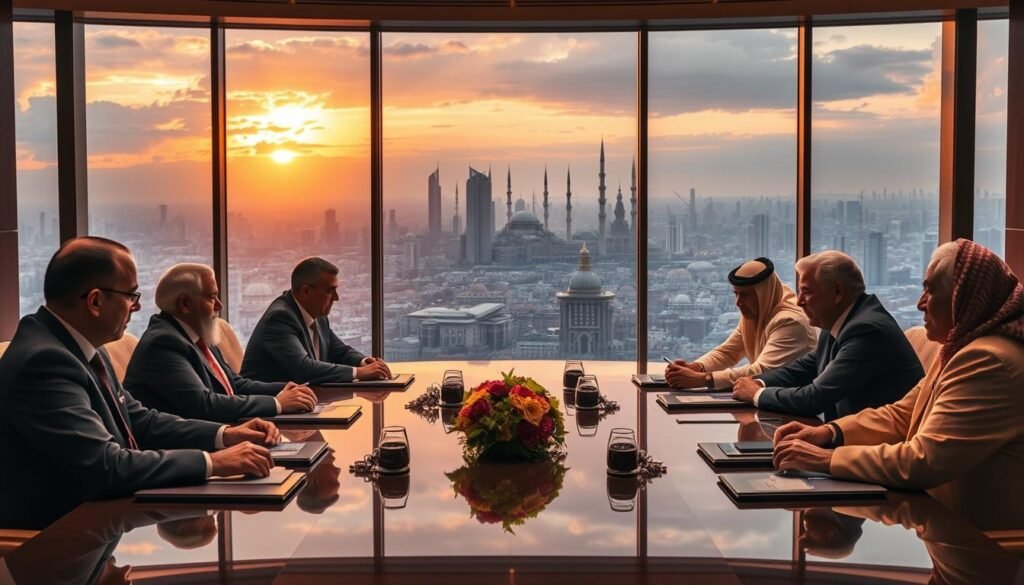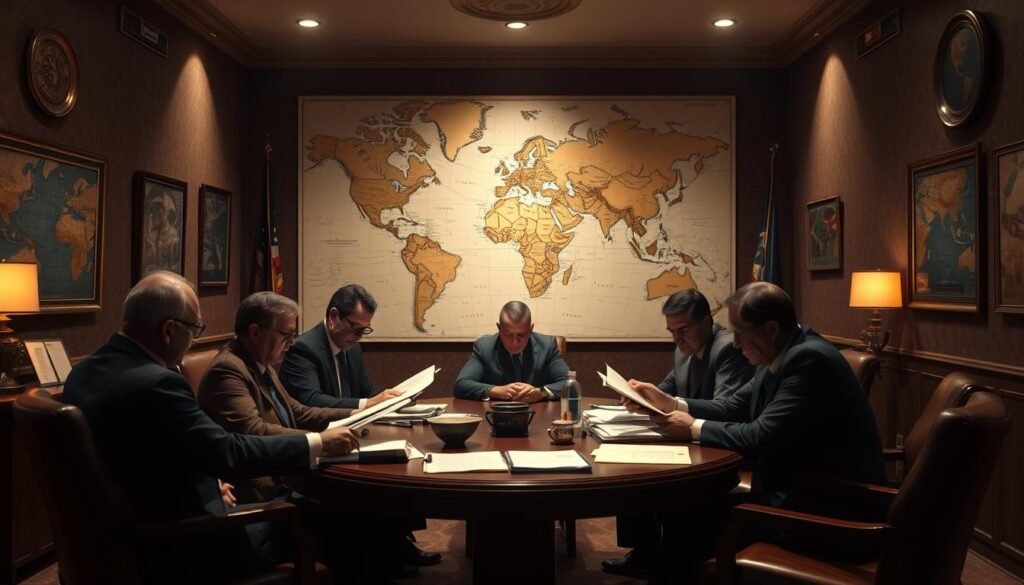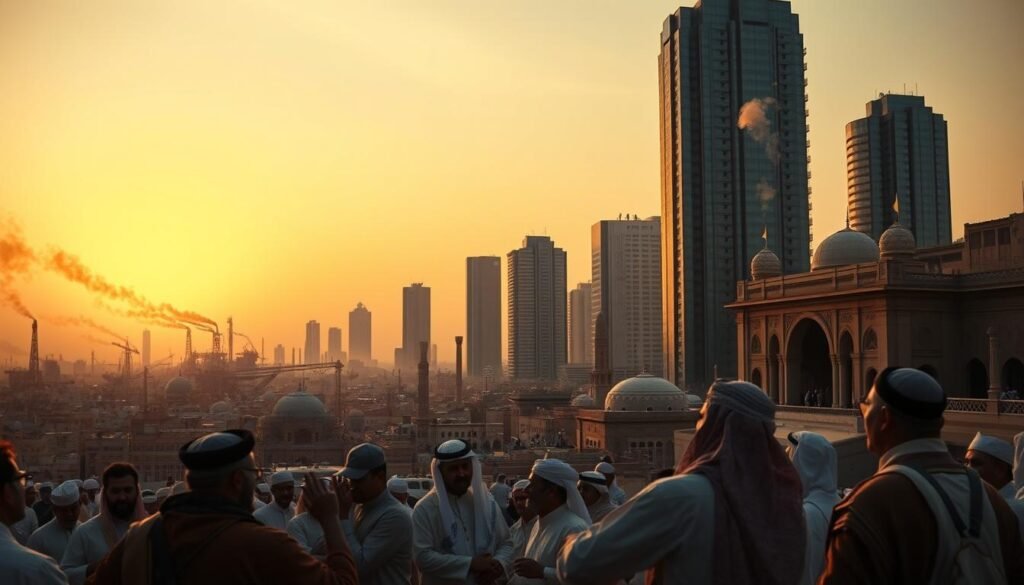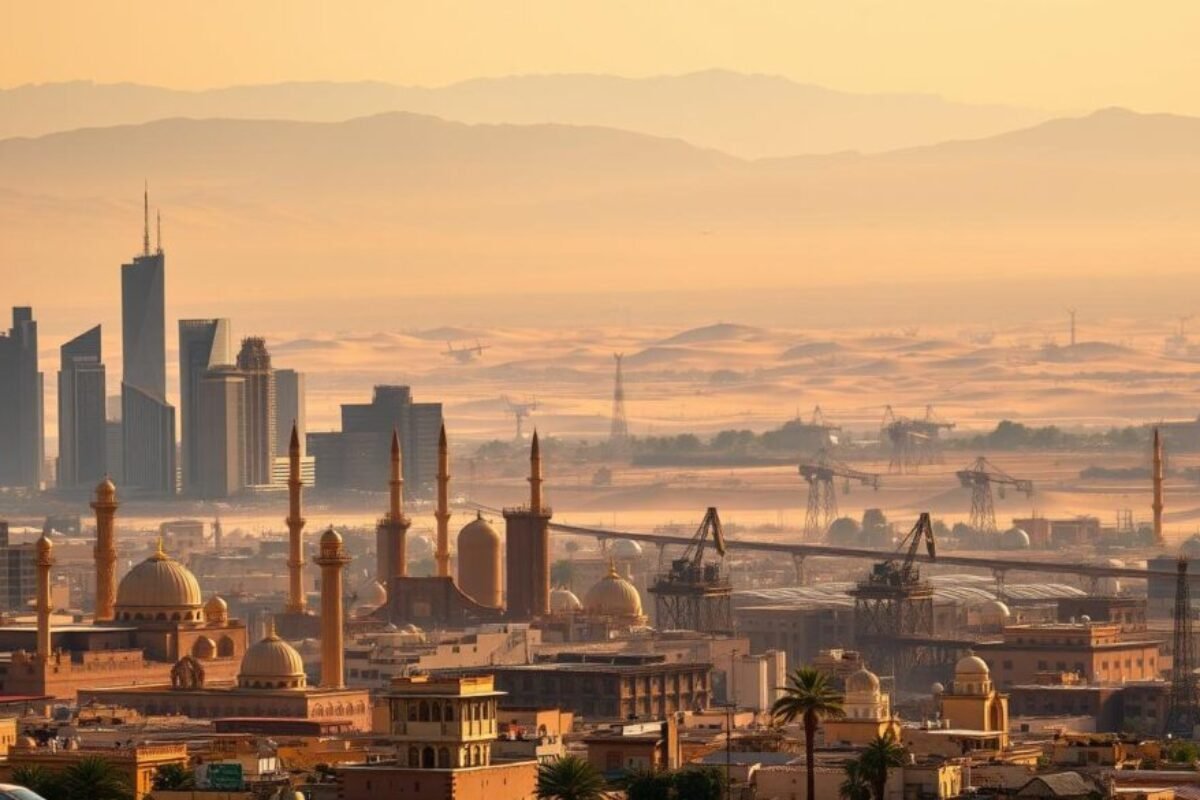Navigating Middle East Conflicts: Energy Diplomacy Insights.
Did you know the Middle East has nearly 50% of the world’s oil reserves? It also has about 40% of the global gas reserves. This illustrates why energy diplomacy is crucial in the region. It helps us understand the complex relationships between energy and politics.
Energy diplomacy is key for countries to achieve their goals in the Middle East. It involves a mix of alliances, conflicts, and the sharing of resources. Countries like Saudi Arabia, Iran, the United States, and Russia use their energy to shape the region and make decisions.
Key Takeaways
- The Middle East holds nearly half of the world’s proven oil reserves.
- The region’s energy resources are central to its geopolitical landscape.
- Energy diplomacy is key for regional stability.
- Key players include both regional powers and global superpowers.
- Understanding energy dynamics is vital for effective diplomacy and policy-making.
Introduction to Middle East Conflicts and Energy Diplomacy
The Middle East is a complex region with many conflicts. Energy resources play a big role in these conflicts. They have been at the heart of power struggles and alliances for a century.
Energy diplomacy is key to understanding Middle East conflicts. It shows why energy security is important for both regional and global stability. Countries use their energy resources to gain power, influence decisions, and navigate international relations.
Here’s a quick look at the
Middle East conflicts overview
and an introduction to energy diplomacy:
| Aspect | Description |
|---|---|
| Historical Context | Long-standing territorial disputes, religious divisions, and colonial legacies. |
| Key Conflicts | Arab-Israeli conflict, Iran-Iraq war, Syrian civil war, and ongoing tensions in Yemen. |
| Energy Resources | Oil and natural gas reserves as vital economic and political assets. |
| Energy Diplomacy | Strategies to secure energy supply and leverage energy assets in diplomatic negotiations. |
The mix of Middle East conflicts and energy diplomacy affects the global energy market. As we learn more, we’ll see how power and resource management shape this volatile region.
Historical Context of Middle East Conflicts
The roots of Middle East historical conflicts are deeply entwined with the region’s rich and complex history. From ancient empires to the rise of modern nation-states, the Middle East has been a crossroads of cultures, religions, and political ambitions.
One key moment was the end of the Ottoman Empire after World War I. The Sykes-Picot Agreement of 1916, made by European powers, drew new borders. These borders often ignored ethnic and sectarian lines, setting the stage for future geopolitical developments and conflict.
The creation of the State of Israel in 1948 increased tensions. This led to multiple Arab-Israeli wars and ongoing disputes over Palestinian statehood. These events have reshaped the geopolitical landscape, affecting both regional alliances and rivalries.
Events like the Iranian Revolution of 1979 and the Iran-Iraq War have had lasting impacts. These conflicts were not just about territorial disputes. They were also about ideological clashes that continue to affect the region.
Understanding the historical context of Middle East conflicts is key to grasping ongoing tensions. By tracing these origins, we can better understand how historical grievances and political ambitions shape today’s geopolitical climate.
Key Players in the Middle East Geopolitical Situation
The Middle East is a complex mix of political landscapes. It’s shaped by the interests of major players. Countries like Saudi Arabia, Iran, Israel, and Turkey are key. They all have big roles in the region.
Saudi Arabia is important because of its oil and religious role. It wants to keep its influence, ensure stability, and stop Iran’s growth. Iran, on the other hand, works to expand its power and support allies.
Israel focuses on keeping its borders safe and secure. Its tech and military make it a big player. Turkey tries to balance its East and West ties, aiming to grow its influence.
Groups like Hezbollah, the Houthis, and Kurdish groups also play a part. They act as proxies for states, making the situation more complex. Their actions affect the region’s stability.
| Country or Group | Primary Interests | Strategies |
|---|---|---|
| Saudi Arabia | Energy dominance, regional stability | Oil production control, military alliances |
| Iran | Regional influence, counteracting Saudi policies | Support for allied groups, military power projection |
| Israel | National security, territorial defence | Military deterrence, technological advancements |
| Turkey | Regional influence, strategic positioning | Geopolitical maneuvering, diplomatic balancing |
| Hezbollah | Resistance against Israel, Iranian alignment | Guerrilla tactics, political involvement |
Knowing who the big players are and what they want is key. Their actions shape the Middle East’s future. They impact global energy and stability.
The Role of Energy Security Strategies in the Region

In recent years, the Middle East has made big steps in improving its energy security plans. These efforts are key to keeping the region stable and building strong partnerships. Thanks to new tech and alliances, the Middle East’s energy strategy is getting stronger.
Recent Developments in Energy Security
Many steps have been taken to boost energy security. There’s a growing focus on renewable energy like solar and wind. Also, gas exports have gone up, making the energy mix more varied.
These moves not only keep energy safe but also make the Middle East a top player in sustainable energy solutions.
Impact on Global Markets
The Middle East’s energy plans have a big effect on the world’s energy market. Any problem with energy from the Middle East can cause big changes in oil prices. This affects many countries’ economies.
It’s important to understand how these policies affect the global energy market. This helps in making smart plans for countries that rely a lot on energy.
| Strategy | Implementation | Global Market Impact |
|---|---|---|
| Renewable Energy Projects | Solar and Wind Investments | Reduces Dependency on Oil |
| Increased Gas Exports | Diversification Efforts | Stabilizes Global Gas Prices |
| Technological Advancements | Smart Grids, AI Integration | Enhances Overall Energy Efficiency |
In summary, the Middle East’s focus on energy security shows its dedication to stability and positive global impact. The mix of old and new energy sources supports this goal.
Understanding Resource Allocation in the Middle East
In the Middle East, managing resources is key to the economy. The area has lots of oil and gas, making it important for the world’s energy needs. It’s all about finding a balance between getting these resources and doing it in a way that’s good for the future.
The way resources are allocated has big effects on the economy. Oil and gas sales help the economy grow, create jobs, and bring in money for governments. But, there are also political and social issues that come with these benefits. Problems like unfair resource sharing can lead to conflicts inside and outside countries.
Managing oil and gas is a big job that involves governments, international deals, and companies. Countries like Saudi Arabia and the UAE have good plans to use their resources well. They use new technologies to get more out of their resources and protect the environment.
The Middle East’s way of managing resources also affects the world. The prices and supply of oil and gas from here shape global markets and energy policies. Looking into how resources are allocated shows how it’s linked to the region’s politics and society.
Diplomatic Solutions for ENERGY Disputes
Effective diplomacy has often played a key role in solving energy disputes in the Middle East. It has led to regional stability and mutual benefits. Successful talks have turned tense standoffs into cooperative agreements, ensuring sustainable energy and economic growth.
Case Studies of Successful Diplomacy
The Iran-Iraq Pipeline Agreement is a great example of successful diplomacy. Years of tension made energy collaborations seem unlikely. But, through mediated talks, they reached a historic pipeline agreement, improving ties and ensuring energy security.
Another example is Saudi Arabia and Kuwait’s deal over oil resources in the Neutral Zone. This shows how patient negotiation can solve big diplomatic challenges in energy disputes.
Challenges and Obstacles
Despite these successes, energy disputes face many challenges. Negotiation obstacles come from conflicting national interests and internal pressures. External factors like sanctions and alliances also complicate things.
International laws and agreements can slow down dispute resolutions. This makes diplomatic efforts complex and demanding.
To overcome these challenges, clear communication, trust-building, and compromise are key. These are vital for navigating the complex world of Middle Eastern energy disputes and finding lasting solutions.
Conflict Resolution in the Middle East
The Middle East has faced a lot of turmoil. But, strategies for peace have shown that stability is possible. Many methods have been used, from diplomacy to direct intervention.
Peace is not merely a distant goal that we seek, but a means by which we arrive at that goal.
One key method is multilateral negotiations. The United Nations has played a big role. They’ve helped get temporary ceasefires and sometimes, full peace agreements.
The Camp David Accords are a great example. Egypt and Israel made peace with U.S. President Jimmy Carter’s help. This showed that diplomacy can lead to real results.
But, not every effort has worked. The region’s complex politics, religious issues, and outside influences make things tough. So, it’s important to keep trying new approaches.
Local groups, like the Arab League, have also helped. They’ve worked to stop violence in places like Lebanon and Yemen. Their efforts aim to solve deep problems and bring lasting peace.
| Strategy | Success Rate | Examples |
|---|---|---|
| Diplomatic Negotiations | High | Camp David Accords, Oslo Accords |
| International Mediation | Moderate | UN Ceasefires in Syria |
| Local Mediation | Variable | Arab League in Yemen |
As we go forward, we need to keep improving our strategies for peace. Only then can we truly resolve conflicts in this troubled region.
Oil Diplomacy in the Middle East

The Middle East is a key player in the world’s energy scene. Strategic oil deals and partnerships shape diplomatic ties. Many countries in the area have made big agreements to control oil production and keep markets stable.
Key Agreements and Partnerships
Important agreements, like those in OPEC, show the value of working together. For example, efforts to limit production help keep oil prices steady. Deals between countries like Saudi Arabia and Russia also play a big role.
These agreements shape the supply chain and affect the global market.
Influence of Oil Prices on Diplomacy
Changes in oil prices greatly affect diplomacy in the Middle East. When oil prices go up, countries can earn more money. This can give them more power in global politics.
But when prices drop, countries face economic problems. This can make it hard to keep good relationships and may lead to new deals.
So, oil prices have a big impact on diplomacy. They shape partnerships in the energy sector and influence economic diplomacy.
Middle East Energy Policies and Their Global Effects
The Middle East’s energy policies have a big impact on the world’s energy. Changes in these policies affect global energy supply, international relations, and economic stability. This shows how energy and politics are closely linked.
The Middle East’s energy policies directly affect the world’s energy supply. When countries in the region change their energy production, the world feels it. For example, changes in Saudi Arabia’s oil production can change global oil prices.
Energy policies in the Middle East also shape international relations. Countries that rely on Middle Eastern oil must balance their diplomatic ties with energy security. This shows the complex nature of global energy dynamics.
The economic stability of countries around the world is influenced by energy policies. When production increases, prices drop, boosting economic activity. But, when production decreases or there’s political instability, prices rise, affecting inflation and growth.
Understanding the Middle East’s energy policies is key to seeing the bigger picture of global energy. It shows how countries are connected through their energy needs.
“Energy policies in the Middle East are more than just regional concerns; they are vital to the stability and dynamics of global energy markets.”
The connection between Middle Eastern energy policies and the global stage highlights the need for strategic planning and international cooperation. This is essential for managing the complex world of global energy dynamics.
The Strait of Hormuz: A Critical Energy Chokepoint
The strategic importance of the Strait of Hormuz is huge. This narrow waterway connects the Persian Gulf to the Gulf of Oman. It’s key for global energy, carrying about 20% of the world’s oil.
Keeping the shipping lane security in the Strait of Hormuz is vital. It helps keep oil prices stable and supply chains running smoothly. Any trouble here can affect markets worldwide.
The area is heavily guarded by military forces. The U.S. and its allies patrol the strait to protect these lanes. This shows how important the strategic importance of the Strait of Hormuz and shipping lane security are.
With the Middle East’s ongoing turmoil, keeping energy flowing through the Strait of Hormuz is a must. It highlights how our global energy system is both connected and fragile.
Regional Stability Initiatives and Their Impact
In recent years, many regional stability initiatives have aimed to bring peace and cooperation to Middle Eastern countries. These efforts are key in lowering tensions and creating a more united geopolitical scene. The success of these peace efforts varies, and their effects on both regional and global stability need a closer look.
The Abraham Accords are a big step towards cooperation, with countries like the UAE and Israel making peace. This move has inspired other nations to think about making peace too.
The Gulf Cooperation Council (GCC) also plays a big role. It helps solve conflicts and boosts economic ties among its members. The GCC’s work in building infrastructure and joint projects shows their commitment to stability.
Saudi Foreign Minister Prince Faisal bin Farhan stated, “Our peace initiatives are designed to ensure long-term stability and growth for all countries in the region.”
International organizations, like the United Nations, are also key. The UN has led peace talks and missions to calm conflicts. These efforts have helped reduce violence and encourage talks between enemies.
To understand these initiatives better, let’s compare some of them:
| Initiative | Key Players | Impact |
|---|---|---|
| Abraham Accords | UAE, Israel | Enhanced diplomatic relations and economic cooperation |
| Gulf Cooperation Council (GCC) | Saudi Arabia, UAE, Kuwait, etc. | Mediation of regional disputes and economic collaboration |
| UN Peace Initiatives | United Nations, Regional States | Conflict de-escalation and promotion of dialogue |
Hostage Negotiations and Their Influence on Energy Diplomacy

Hostage situations in the Middle East have greatly affected international relations. They have a big role in energy diplomacy. By looking at historical analyses of hostage crises, we see how these events change alliances and energy policies.
Historical Hostage Situations
The Iran Hostage Crisis of 1979 is a key example. It lasted for 444 days, holding 52 American diplomats and citizens. This crisis strained U.S.-Iran relations and had big effects worldwide. It showed how important it is to balance energy needs with political stability.
Current Negotiations and Implications
Today, hostage negotiations are changing regional stability and energy markets. For example, the recent hostages in Syria are causing big diplomatic impacts. Countries are working hard to solve these problems. These talks are key in shaping energy diplomacy strategies.
- Resolving these situations is vital for keeping energy supplies flowing.
- Diplomatic efforts often bring together many nations, creating temporary alliances.
- The results of these talks affect regional stability and the global energy market.
Investment Opportunities in Conflict Zones
Investing in conflict zones is both challenging and rewarding. These areas offer high-risk investment opportunities with the chance for big returns. It’s important to understand the economic prospects in places like Iraq, Syria, and Yemen.
Investments often focus on energy, rebuilding infrastructure, and technology. For example, Iraq’s rebuilding needs create big opportunities in infrastructure. This can lead to significant economic growth.
The vast natural resources in these zones also offer great chances. Iraq and Syria have untapped oil and gas reserves. But, investing here requires knowing the local politics and managing risks well.
The table below shows key sectors for investment in conflict zones:
| Country | Key Investment Sectors | Potential Rewards | Associated Risks |
|---|---|---|---|
| Iraq | Infrastructure, Oil & Gas | High returns from reconstruction efforts | Political instability, security threats |
| Syria | Energy, Technology | Significant ROI in underdeveloped sectors | Ongoing conflict, regulatory challenges |
| Yemen | Renewable Energy, Water Infrastructure | Market growth, humanitarian impact | Persistent conflict, infrastructural damage |
Exploring these areas shows great rewards are possible. But, investors must be careful and well-prepared. They need to understand the risks and how to manage them in these unstable places.
Sanctions and Their Effects on Energy Markets

Economic sanctions have a big impact on energy markets in the Middle East. They are used to put financial pressure on countries. This can cause big problems for getting energy resources.
Trade restrictions make things even harder for both those who make and use energy. It’s a tough situation for everyone involved.
The economic sanctions impact is huge for Middle Eastern countries. They can change oil prices, affect investments, and shift trade partnerships. Countries under sanctions have to deal with these issues and stay strong in the global energy market.
Sanctions last a long time and shape energy policies in the region. Countries under sanctions face tech and money problems. They can’t build new energy projects or keep old ones running well.
They have to look for new markets or tech help. This can lead to unexpected partnerships.
The effects of economic sanctions on energy markets go beyond the Middle East. When global oil supply chains get disrupted, prices can swing wildly. This price volatility can hurt the economies of countries that import energy. It shows how sanctions in the Middle East can affect the world’s economy.
Energy Infrastructure Development in the Middle East
The Middle East is key for energy infrastructure growth. It focuses on oil, gas, and renewable energy. But, developers face many challenges that slow down projects.
Major Projects and Their Progress
Many big energy projects are changing the Middle East’s energy scene. These include new pipelines, advanced refineries, and green energy projects. For example, Saudi Arabia’s NEOM aims to be a city powered by renewables.
The United Arab Emirates is also big on solar power. The Mohammed bin Rashid Al Maktoum Solar Park is a major step forward in green energy.
The table below shows the status of major energy projects in the region:
| Project Name | Location | Status | Est. Completion |
|---|---|---|---|
| NEOM | Saudi Arabia | In Progress | 2030 |
| Mohammed bin Rashid Al Maktoum Solar Park | UAE | Phase 3 Completed | 2025 |
| Iraq-Turkey Pipeline | Iraq-Turkey | In Planning | 2027 |
Challenges Faced by Developers
Developers in the Middle East face many hurdles. Political instability can delay projects. Economic ups and downs can also impact funding.
Logistical problems, like the desert climate and complex rules, add to the challenges. To succeed, developers need strong project management and teamwork with local groups.
By tackling these issues, developers can help the Middle East’s energy future. This will boost global energy security and sustainable growth.
Middle East Conflicts and Energy Diplomacy

Looking into the Middle East, we see how conflict and diplomacy are closely tied. Wars in Yemen, Syria, and Iraq affect the region’s energy talks. These talks are key to solving these conflicts.
These wars can change oil prices and affect the world’s energy markets. The fight for oil fields is a big deal in these power struggles. Who controls the oil can shape alliances and change who’s in charge.
The mix of war and diplomacy is complex. Peace talks often hide energy goals. This shows how important it is to know about resources and who wants what.
Our analysis of conflict and diplomacy shows energy’s role in these battles. It’s a tool and a target. Diplomats must think about energy when trying to make peace.
To understand this complex mix, let’s look at countries deeply affected:
| Country | Conflict Impact | Energy Diplomacy Efforts |
|---|---|---|
| Syria | Significant destruction of infrastructure | Efforts to control oil fields to fund military operations |
| Iraq | Internal unrest impacting oil production | Negotiations with OPEC to stabilize market |
| Yemen | Humanitarian crisis and blockade | International efforts to secure shipping lanes |
| Saudi Arabia | Defense expenditures impacting economy | Leading role in OPEC for market stability |
These examples show how energy diplomacy can lead to conflict and vice versa. Understanding these ties helps navigate the Middle East’s complex politics.
The Future of Middle East Energy Diplomacy
The Middle East’s energy diplomacy is set for big changes in the next decade. The changing world politics means we must look ahead and plan for energy diplomacy’s future. We need strong forecast analysis to handle any surprises.
Predictions for the Next Decade
In the next years, we’ll see more focus on renewable energy in the Middle East. Countries will mix up their energy sources to meet global goals for peace and the environment. Diplomats will work together more to keep energy safe and stable.
Political alliances will change, with some countries moving to solar and wind power. This could reduce fights over oil and lead to better global energy teamwork.
Strategies for Moving Forward
To handle energy diplomacy’s future, countries need solid plans. Building strong partnerships and working together regionally is key. Also, investing in new tech and energy projects will make the sector strong and varied.
It’s also vital to focus on peace through diplomacy. By working on clear talks and deals, the Middle East can avoid conflicts. This will help the region become more secure and wealthy in the long run.
Conclusion
Looking back at our deep dive into Middle East conflicts and energy diplomacy, we see how closely these topics are linked. The historical context helped us understand the roots of these tensions. It also showed us the key players and their roles in the conflicts.
Energy security and how resources are used are at the heart of these issues. This shows how important oil and gas are in shaping diplomatic relations.
We looked at different ways to solve conflicts and the role of the Strait of Hormuz. This showed how important it is to be strategic and informed in the Middle East. The connection between national energy policies and global markets shows that decisions here affect the world.
Sanctions, hostage negotiations, and investment in conflict zones are complex challenges. Yet, they also offer opportunities in Middle East energy diplomacy.
Looking ahead, our insights highlight the need for continued, careful involvement in the region. The future may face many challenges, but it also holds promise for energy security and stability. By being informed and strategic, we can help make the Middle East more stable and prosperous. This will benefit both regional and global energy markets.




